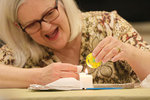
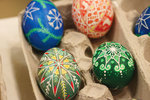
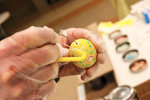
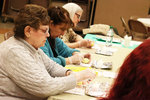
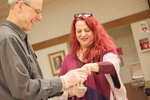
NORTH KINGSTOWN — When devout Ukrainian women begin to decorate Pysanky, Ukrainian Easter eggs, they make the sign of the cross and whisper, “God help me!” They do this to assure that the profound religious meanings symbolized in the intricate designs they apply to the eggs come to life in the eyes of the faithful who will see them on Easter morning.
Ladders suggest prayer, a rose, or eight-pointed star is an ancient symbol for Christ and the Resurrection of the Savior. A grapevine symbolizes the good fruits of the Christian life.
“I probably have six or seven eggs,” said St. Francis de Sales parishioner Carol McHugh, of the brightly colored, delicate and fancifully decorated eggs she has created, one for each of the years she has attended Thomas Gavula’s class in designing and decorating Ukrainian Easter eggs at the parish.
Gavula, also a parishioner, decides a new design to try each year.
The son of a Byzantine Catholic father and Roman Catholic mother, he grew up worshipping in both faiths in his native Philadelphia.
“I was taught this as a kid in grade school,” Gavula said.
“My father taught us what I call the Polish method. It was easy for kids because the tool was just a pencil with a straight pin stuck in the eraser, and you melted a little cup of beeswax on the stove and you dipped the head of the pin in the beeswax and just a little bit of the beeswax would be held on the end of the pin, and then you’d put it on the egg and make a stroke.”
It was when he started high school that Gavula learned the Ukrainian method of decorating. On the walk to school one day he stopped in at a gift shop and purchased his first Ukrainian Easter egg decorating kit.
This method employs a kistka, which is known as a funnel on a stick in which a quarter-inch piece of beeswax is melted over flame of a candle to make the ink used to draw the initial design.
“It’s just like drawing on the egg and the ink is the black wax,” he said, during the final class of three sessions he led this year.
For the last eight years Gavula has led classes at his church in decorating in the Ukrainian style. He tries to follow a different design pattern each year.
On this night, he opened with a prayer for the people of Ukraine who are embattled in a war with neighboring Russia.
“Let us pray tonight for the people of Ukraine, who unfortunately, for a lot of them, won’t be able to decorate their eggs this year,” Gavula began.
The process involves making a series of dots and strokes on each hollowed out egg, before colors are applied by dipping each egg in a dye solution.
“You hold the kistka like a pencil for control and draw your design,” Gavula teaches.
“If it doesn’t crack, it will last forever.”
Erin Cooney, in her second year of attending the class, is joined by her mother, Arlene Cooney, a veteran of the past seven or eight sessions.
“When you’re doing it you’re saying to yourself, ‘there’s no way this is going to look good when it’s done.’ And then you see how beautiful it comes out,” Erin said.
Arlene enjoys the craft, as well as spending time with her daughter. “It’s a fun tradition. It’s amazing when they’re done. I’m not that good at it, but it’s amazing that they come out nice anyway,” she said.
Carol and Maureen McHugh are another mother-daughter team practicing the art. “Tom’s great, he has unbelievable patience,” Carol said.
Vera DePalo is proud to have four such eggs at home.
“They’re so pretty, so nice,” she said. “I keep them in an old crystal dish.”
Barbara Rickert, a parishioner at St. Gregory the Great Parish in Warwick, has her own favorite receptacle in which to display her prized eggs.
“Old-fashioned salt cellars are great egg holders,” she said with a broad smile.